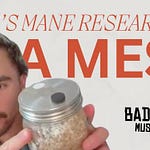One Random Quote: "There is surely nothing quite so useless as doing with great efficiency what should not be done at all." - Peter Drucker
How Do We Approach Cultivating Mushrooms?
It’s an easy question, but it has a long answer. I’m going to give you a (not-so) brief overview of how Badwater Mushrooms approaches its cultivation of Lion’s Mane and other medicinal mushrooms.
Let’s simplify it. The primary objective of a mushroom cultivator is to create a fungus so happy that it produces fruiting bodies, or the mushrooms we all recognize and adore.
I’m emphasizing the word “fungus” here for a specific reason, because people tend to visualize the mushroom fruiting body throughout the entire mushroom-growing process, but those bodies arrive only at the very last step.
In reality, we have a network of fungi called mycelium that’s growing in various growing mediums, such as grains and oak or soy pellets. The fungi feeds and absorbs nutrients until they’re happy enough to produce fruiting bodies.
Badwater Mushrooms is a reader-supported publication. To receive new posts and support my work, consider becoming a free or paid subscriber.
Now that we have the fungus in mind: The mushroom cultivator’s fungus is either in a liquid form or grown on petri dishes. We inject or mix the fungus culture into a jar filled with grains, like rye, millet, or oats. Now, let’s transition to calling this phase of the fungi’s life mycelium.
Why use grains to help grow the mycelium in this first step, you might ask? In his book Growing Gourmet and Medicinal Mushrooms, Paul Stamets provides on explanation: “The grain is not only a vehicle for evenly distributing the mycelium, but also a nutritional supplement. Whole grain is used because each kernel becomes a mycelial capsule, a platform from which mycelia can leap into the surrounding expanse.”
In the end, grains are a very accessible organic medium and, of all the bulk organic products that we have commercial access to, it's been the most productive for mycelial growth. You’ll see with more experimental hobbyists that mycelium is happy to eat a lot of organic things in life, so long as it has the correct pH balance and nutrients. Brown rice, bird seed, popcorn are all included.
We’ve mixed the mycelial culture into grains and spend about 10-14 days for the grains to be colonized.
Whereas in the syringe or the petri dish mycelium slowly grew eating a simple sugar, now, we gave them more a concentration of complex nutrients that allows the mycelium to pretty explode in their speed of growth. Their cell divisions multiply from millions to billions and trillions. This is an important step in the cultivation process because you're giving the culture the momentum of growth it needs to start developing those fruiting bodies.
Once the grains are fully overtaken by mycelium, we then have “grain spawn”. It’s now ready to mix into what we call substrate.
To understand substrate, I want to introduce an important universal for mushroom cultivation: The Law of Contamination, which states that “in due time, everything will contaminate, and all will be lost.” Yes, a little dramatic, but the cultivator understands that if we do everything correctly, we’ll already have our fruiting bodies by the time contamination takes over a mushroom growing block.
Mushroom cultivation is the art of delaying the inevitable.
Substrate, an organic medium, provides mushrooms with an even higher concentration of nutrients, making them so happy that they eagerly produce fruiting bodies. This is usually made of a base substrate like oak or straw, and supplemental nutrients like wheat bran or soy hulls.
“Why don’t you mix the mycelial culture directly into the substrate, allowing it to start fruiting right away, instead of waiting for the grain spawn to propagate?”
And this is where I invoke the Law of Contamination. Frustratingly enough, substrate growing blocks (which in our case is a 5lb, 50:50 mix of oak and soyhull pellets in a heat-resistant bag), are so full of good nutrients for mushrooms that even bacteria loves it. While the mushroom culture is spending weeks to directly colonize a substrate bag, the bacteria has already taken the bag over by the second week.
As we introduce higher concentrations of nutrients to the growing medium, we are cutting down the timeline until contamination. By this two-step process of grain spawn to substrate, we are providing that growth momentum that allows the mycelium to beat the bacterial growth that is occurring in the bag.
Oh, boy, am I talking about contamination a lot, aren’t I? It’s the sole reason why someone can’t grow their own mushrooms on a whim. 60% of the work mushroom cultivators do is protect the mycelium from contamination during transfers between syringes, petri dishes, grain jars, and substrate bags.
Contamination is the difference between dozens of pounds of fruiting bodies in one day to one month of moldy grains and oak pellets.
To recap, the mushroom cultivator’s goal is to make mycelium so happy it wants to create fruiting bodies. It does this by providing the mycelium with great nutrient mediums like grains and oak.
But with this nutritious food comes the faster likelihood of bacterial contamination, which can only be delayed with sanitation and sterilization techniques. So you make the mycelium happy fast enough before the mold arrives.
In the early stages of our hobbyist operations, the fruiting stage was always perilous. It could take up to two weeks for the substrate bags to colonize before we notice small clusters of green or red mold rapidly spreading across a bag. At that point, we had to throw those bags out immediately because the molds will release their own spores into the air, which are both harmful to humans and potentially lethal to other grow bags.
I am grateful that our thorough sanitation and sterilization processes have reduced the number of grow bag contaminations to the extent that a single hand can count them—over the past 1.5 years.
Grow more,
Dom
PS - Don’t ask about our grain spawn contamination rates though! :(












